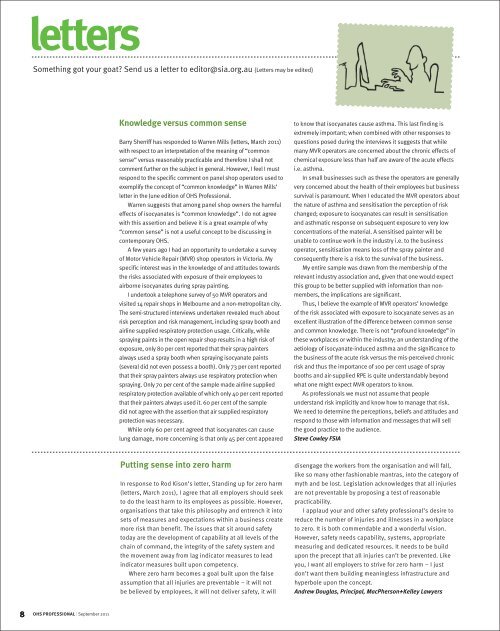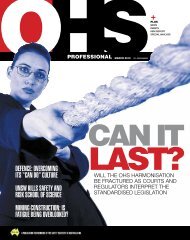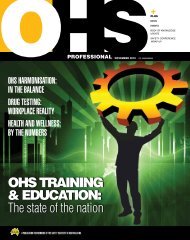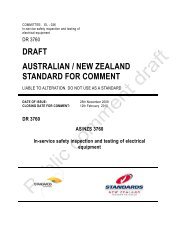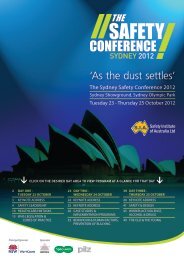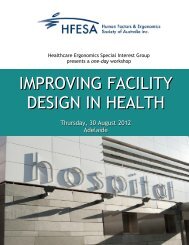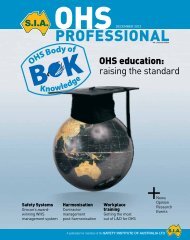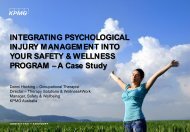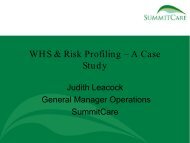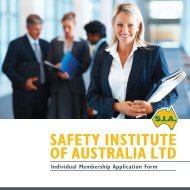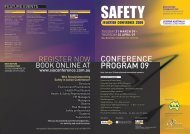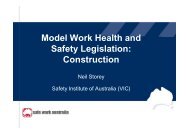Workplace bullying - Safety Institute of Australia
Workplace bullying - Safety Institute of Australia
Workplace bullying - Safety Institute of Australia
Create successful ePaper yourself
Turn your PDF publications into a flip-book with our unique Google optimized e-Paper software.
letters<br />
Something got your goat Send us a letter to editor@sia.org.au {Letters may be edited}<br />
Knowledge versus common sense<br />
Barry Sherriff has responded to Warren Mills (letters, March 2011)<br />
with respect to an interpretation <strong>of</strong> the meaning <strong>of</strong> “common<br />
sense” versus reasonably practicable and therefore I shall not<br />
comment further on the subject in general. However, I feel I must<br />
respond to the specific comment on panel shop operators used to<br />
exemplify the concept <strong>of</strong> “common knowledge” in Warren Mills’<br />
letter in the June edition <strong>of</strong> OHS Pr<strong>of</strong>essional.<br />
Warren suggests that among panel shop owners the harmful<br />
effects <strong>of</strong> isocyanates is “common knowledge”. I do not agree<br />
with this assertion and believe it is a great example <strong>of</strong> why<br />
“common sense” is not a useful concept to be discussing in<br />
contemporary OHS.<br />
A few years ago I had an opportunity to undertake a survey<br />
<strong>of</strong> Motor Vehicle Repair (MVR) shop operators in Victoria. My<br />
specific interest was in the knowledge <strong>of</strong> and attitudes towards<br />
the risks associated with exposure <strong>of</strong> their employees to<br />
airborne isocyanates during spray painting.<br />
I undertook a telephone survey <strong>of</strong> 50 MVR operators and<br />
visited 14 repair shops in Melbourne and a non-metropolitan city.<br />
The semi-structured interviews undertaken revealed much about<br />
risk perception and risk management, including spray booth and<br />
airline supplied respiratory protection usage. Critically, while<br />
spraying paints in the open repair shop results in a high risk <strong>of</strong><br />
exposure, only 80 per cent reported that their spray painters<br />
always used a spray booth when spraying isocyanate paints<br />
(several did not even possess a booth). Only 73 per cent reported<br />
that their spray painters always use respiratory protection when<br />
spraying. Only 70 per cent <strong>of</strong> the sample made airline supplied<br />
respiratory protection available <strong>of</strong> which only 40 per cent reported<br />
that their painters always used it. 60 per cent <strong>of</strong> the sample<br />
did not agree with the assertion that air supplied respiratory<br />
protection was necessary.<br />
While only 60 per cent agreed that isocyanates can cause<br />
lung damage, more concerning is that only 45 per cent appeared<br />
to know that isocyanates cause asthma. This last finding is<br />
extremely important; when combined with other responses to<br />
questions posed during the interviews it suggests that while<br />
many MVR operators are concerned about the chronic effects <strong>of</strong><br />
chemical exposure less than half are aware <strong>of</strong> the acute effects<br />
i.e. asthma.<br />
In small businesses such as these the operators are generally<br />
very concerned about the health <strong>of</strong> their employees but business<br />
survival is paramount. When I educated the MVR operators about<br />
the nature <strong>of</strong> asthma and sensitisation the perception <strong>of</strong> risk<br />
changed; exposure to isocyanates can result in sensitisation<br />
and asthmatic response on subsequent exposure to very low<br />
concentrations <strong>of</strong> the material. A sensitised painter will be<br />
unable to continue work in the industry i.e. to the business<br />
operator, sensitisation means loss <strong>of</strong> the spray painter and<br />
consequently there is a risk to the survival <strong>of</strong> the business.<br />
My entire sample was drawn from the membership <strong>of</strong> the<br />
relevant industry association and, given that one would expect<br />
this group to be better supplied with information than nonmembers,<br />
the implications are significant.<br />
Thus, I believe the example <strong>of</strong> MVR operators’ knowledge<br />
<strong>of</strong> the risk associated with exposure to isocyanate serves as an<br />
excellent illustration <strong>of</strong> the difference between common sense<br />
and common knowledge. There is not “pr<strong>of</strong>ound knowledge” in<br />
these workplaces or within the industry; an understanding <strong>of</strong> the<br />
aetiology <strong>of</strong> isocyanate-induced asthma and the significance to<br />
the business <strong>of</strong> the acute risk versus the mis-perceived chronic<br />
risk and thus the importance <strong>of</strong> 100 per cent usage <strong>of</strong> spray<br />
booths and air-supplied RPE is quite understandably beyond<br />
what one might expect MVR operators to know.<br />
As pr<strong>of</strong>essionals we must not assume that people<br />
understand risk implicitly and know how to manage that risk.<br />
We need to determine the perceptions, beliefs and attitudes and<br />
respond to those with information and messages that will sell<br />
the good practice to the audience.<br />
Steve Cowley FSIA<br />
Putting sense into zero harm<br />
In response to Rod Kison’s letter, Standing up for zero harm<br />
(letters, March 2011), I agree that all employers should seek<br />
to do the least harm to its employees as possible. However,<br />
organisations that take this philosophy and entrench it into<br />
sets <strong>of</strong> measures and expectations within a business create<br />
more risk than benefit. The issues that sit around safety<br />
today are the development <strong>of</strong> capability at all levels <strong>of</strong> the<br />
chain <strong>of</strong> command, the integrity <strong>of</strong> the safety system and<br />
the movement away from lag indicator measures to lead<br />
indicator measures built upon competency.<br />
Where zero harm becomes a goal built upon the false<br />
assumption that all injuries are preventable – it will not<br />
be believed by employees, it will not deliver safety, it will<br />
disengage the workers from the organisation and will fall,<br />
like so many other fashionable mantras, into the category <strong>of</strong><br />
myth and be lost. Legislation acknowledges that all injuries<br />
are not preventable by proposing a test <strong>of</strong> reasonable<br />
practicability.<br />
I applaud your and other safety pr<strong>of</strong>essional’s desire to<br />
reduce the number <strong>of</strong> injuries and illnesses in a workplace<br />
to zero. It is both commendable and a wonderful vision.<br />
However, safety needs capability, systems, appropriate<br />
measuring and dedicated resources. It needs to be build<br />
upon the precept that all injuries can’t be prevented. Like<br />
you, I want all employers to strive for zero harm – I just<br />
don’t want them building meaningless infrastructure and<br />
hyperbole upon the concept.<br />
Andrew Douglas, Principal, MacPherson+Kelley Lawyers<br />
8<br />
OHS PROFESSIONAL | September 2011


